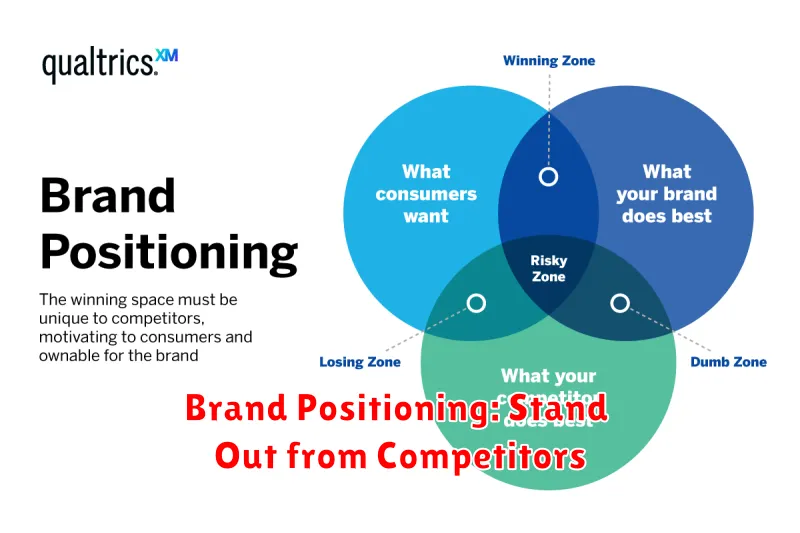In today’s saturated marketplace, brand positioning is more critical than ever. It’s the strategic process of establishing your brand’s unique value proposition in the minds of your target consumers. Effective brand positioning differentiates your offerings from competitors, highlighting what makes you stand out and compelling customers to choose you. This involves a deep understanding of your target audience, competitive landscape, and the unique strengths your brand brings to the table. Without a clear and well-defined brand position, your marketing efforts may fall flat, leaving your brand lost in the noise.
This article will explore the essential elements of successful brand positioning and provide practical strategies to help you stand out from competitors. We will delve into the importance of identifying your target audience, analyzing your competition, and crafting a compelling brand message. By mastering these techniques, you can elevate your brand above the competition, attract loyal customers, and drive sustainable growth. Learn how to create a brand position that resonates with your audience and sets the foundation for long-term success.
Understanding Market Positioning
Market positioning is the strategic process of establishing a distinct and desirable image for your brand in the minds of your target consumers, relative to the competition. It’s about how consumers perceive your brand and its offerings compared to alternatives. A strong market position differentiates your brand, making it more appealing and relevant to your chosen customer segment.
Effective market positioning relies on several key factors:
- Identifying your target audience: Understanding their needs, preferences, and purchasing behaviors is crucial.
- Analyzing the competitive landscape: Knowing your competitors’ strengths, weaknesses, and positioning strategies is essential.
- Defining your unique value proposition: What sets your brand apart and why should customers choose you over the competition?
By carefully considering these elements, you can develop a market positioning strategy that resonates with your target audience and creates a competitive advantage.
Analyzing Competitor Messaging
Understanding your competitors’ messaging is crucial for effective brand positioning. This involves dissecting how they communicate their value proposition to the target audience. Competitor messaging analysis reveals what they emphasize, the language they use, and the overall image they project.
Start by identifying your key competitors. Then, examine their marketing materials, including websites, advertisements, social media presence, and any publicly available content. Pay close attention to the following:
- Value Proposition: What core benefits do they highlight?
- Target Audience: Who are they trying to reach, and how do they tailor their message?
- Tone of Voice: Is it formal, informal, playful, or serious?
- Keywords and Phrases: What specific language do they use to describe their products or services?
- Visual Elements: What kind of imagery, colors, and fonts do they employ?
Documenting these elements in a competitive analysis matrix can provide a clear overview and help identify opportunities to differentiate your brand.
Defining Your Unique Value

Defining your unique value proposition is crucial for effective brand positioning. This involves identifying what sets your brand apart from competitors and what distinct benefits you offer to your target audience. This isn’t just about features, but about the overall value and experience customers receive.
Start by analyzing your strengths. What are you exceptionally good at? Consider your internal capabilities, resources, and expertise. Perhaps you have a unique production process, superior customer service, or specialized knowledge in a niche area. Identify these core competencies and consider how they translate into tangible benefits for your customers.
Next, examine customer needs and pain points. What problems do your customers face that your competitors aren’t effectively addressing? By understanding these unmet needs, you can position your brand as the solution and highlight the unique value you bring to the table. This could involve offering a more convenient service, a more personalized experience, or a higher quality product.
Finally, differentiate yourself from the competition. What makes you distinct? This could be your brand’s story, your values, your approach to sustainability, or even your unique brand personality. Articulating these differentiators helps to clarify your position in the market and create a lasting impression on your target audience. By focusing on what truly sets you apart, you can establish a strong brand identity and build a loyal customer base.
Creating a Positioning Statement
A positioning statement is a concise articulation of your brand’s unique value proposition and target audience. It serves as an internal guide for all marketing and communication efforts, ensuring consistency and clarity in how your brand is presented. A well-crafted positioning statement distinguishes you from competitors and resonates with your ideal customers.
A common framework for developing a positioning statement is:
For [Target Audience], [Brand Name] is the [Frame of Reference] that [Point of Difference] because [Reason to Believe].
Let’s break down each component:
- Target Audience: Clearly define the specific group of consumers you aim to reach.
- Brand Name: Your company or product name.
- Frame of Reference: The market category or segment in which your brand competes.
- Point of Difference: What makes your brand unique and superior to competitors. This should be a compelling benefit.
- Reason to Believe: Evidence or justification supporting your point of difference. This could be data, testimonials, or unique features.
By thoughtfully filling in each element of this framework, you create a focused and powerful positioning statement that guides your brand strategy and resonates with your target audience. This statement should be concise, memorable, and easily understood by everyone within your organization.
Aligning with Target Audience
A crucial aspect of effective brand positioning is aligning your message with your target audience. Understanding their needs, desires, and pain points allows you to tailor your communication and resonate deeply with them. This alignment creates a stronger connection and fosters brand loyalty.
Start by clearly defining your target audience. Consider demographics, psychographics, buying behaviors, and online activity. Create detailed buyer personas to represent your ideal customers. This allows you to visualize and understand their motivations and preferences.
Once you have a clear understanding of your target audience, analyze how your brand positioning resonates with them. Does it address their needs and speak their language? Refine your messaging to ensure it aligns with their values and aspirations.
Consider the channels your target audience frequents. Are they primarily on social media, engaging with online forums, or attending industry events? Tailor your communication strategy to reach them where they are most active. This ensures maximum visibility and engagement.
Evaluating Brand Perception
Evaluating brand perception is crucial for understanding how your target audience views your brand. It provides insights into the effectiveness of your brand messaging and overall brand strategy. This process involves gathering and analyzing data from various sources to gain a comprehensive understanding of your brand’s image and reputation.
Key areas to consider when evaluating brand perception include:
- Brand Awareness: How familiar are consumers with your brand?
- Brand Associations: What thoughts, feelings, and attributes do consumers connect with your brand?
- Brand Value: What is the perceived worth of your brand compared to competitors?
- Customer Loyalty: How likely are customers to repurchase and recommend your brand?
Several methods can be employed to gather data for brand perception evaluation. Surveys and focus groups can provide direct feedback from consumers. Social media monitoring offers insights into public conversations about your brand. Competitor analysis helps benchmark your brand’s perception against industry rivals.

